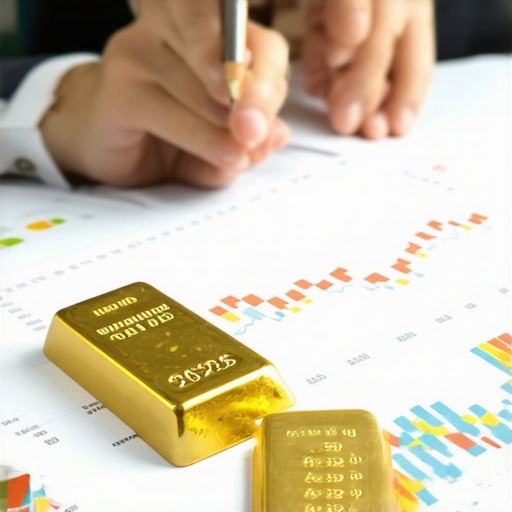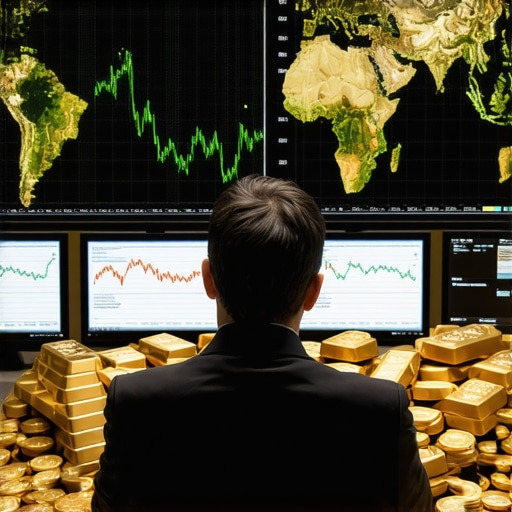Understanding the Dynamics of Gold Demand: Jewelry and Industry as Price Drivers for 2025
As experts in the precious metals market, we recognize that gold demand in jewelry and industrial sectors significantly influences price trajectories, especially within the context of the 2025 market outlook. Both segments exhibit complex interaction—where consumer preferences, technological advancements, and macroeconomic factors converge to shape supply-demand equilibria. This article explores these nuanced influences, providing a comprehensive analysis rooted in current trends and expert forecasts.
Deciphering Jewelry Demand: The Cultural and Economic Catalysts
Jewelry remains the largest consumer of gold globally, with demand patterns heavily influenced by cultural traditions and economic stability. In regions like India and China, cultural affinity sustains high demand, but shifts in disposable income and luxury spending can either buoy or dampen this sector. According to market analysis reports, a potential slowdown in these markets could temper gold’s price escalation, despite rising investment interest.
Industry Demand: Technological Innovation and Green Energy as Emerging Factors
Gold’s industrial applications, notably in electronics, renewable energy, and medical devices, are poised to expand with technological innovation. The surge in demand for high-performance components and environmentally sustainable solutions could propel industrial consumption to new levels. Notably, the adoption of gold-based conductive materials in green technology aligns with global decarbonization efforts, potentially creating a sustained upward pressure on prices. For deeper insight, see industry demand forecasts.
Expert Predictions: Will Supply Tighten or Ease in 2025?
Despite rising demand, supply-side constraints—such as central bank gold purchases and mining output limitations—are critical factors. The World Gold Council suggests that central bank buying patterns could amplify price gains, especially if geopolitical tensions prompt strategic reserves accumulation. Conversely, new mining projects and recycling initiatives may offset some supply tightness, creating a dynamic market equilibrium. For an in-depth analysis, consult market analysis reports.
How Will Fluctuations in Jewelry and Industrial Demand Interact with Global Economic Trends in 2025?
Investigating this question requires an understanding of macroeconomic indicators, inflationary pressures, and technological shifts. A nuanced approach considers how geopolitical stability, currency fluctuations, and innovation cycles influence demand elasticity and price volatility. For example, increased infrastructure investments in emerging economies could boost industrial demand, whereas cultural shifts in consumer spending might alter jewelry consumption patterns. This layered interplay underscores the importance of monitoring future demand drivers.
If you’re interested in refining your investment strategy, explore our expert tips for safe gold investments in 2025 or contribute your insights on market trends to foster a collaborative understanding of this evolving landscape.
Navigating the Complex Web of Gold Demand in 2025: Cultural, Technological, and Economic Perspectives
As gold continues to serve as a barometer for economic stability and a symbol of cultural tradition, understanding its multifaceted demand in 2025 becomes crucial for investors aiming to optimize their portfolios. The interplay between jewelry demand, industrial applications, and macroeconomic factors shapes the gold market’s future trajectory, demanding a nuanced analysis rooted in current trends and expert forecasts.
How Will Shifts in Cultural and Economic Trends Influence Jewelry Gold Demand in 2025?
Jewelry remains the dominant consumer of gold worldwide. Cultural preferences, particularly in regions like India and China, sustain high demand levels; however, fluctuations in income levels, luxury spending, and changing cultural attitudes could significantly impact this sector. According to market analysis reports, any slowdown in these key markets could temper gold price growth despite rising investment interest. Moreover, shifts toward sustainable and ethically sourced jewelry are influencing consumer choices, adding an extra layer of complexity to demand forecasting.
Industrial Demand: The Rising Role of Green Technologies and Advanced Electronics
In parallel, industrial applications of gold are expanding, driven by technological innovation and sustainability goals. The adoption of gold-based conductive materials in electronics, renewable energy systems, and medical devices reflects a strategic shift that could elevate industrial demand. As highlighted by industry demand forecasts, the push toward green energy solutions such as solar panels and electric vehicles underscores gold’s vital role in emerging technologies. This trend may sustain upward price momentum, especially if technological breakthroughs accelerate adoption rates.
Will Supply Constraints Amplify Price Volatility in 2025?
Supply-side factors are equally pivotal. Central bank gold purchases, mining output limitations, and recycling efforts intertwine to create a dynamic supply landscape. The World Gold Council indicates that central bank buying patterns could be a significant driver of price increases, especially amid geopolitical tensions and currency fluctuations. Conversely, new mining projects and enhanced recycling technologies might mitigate some supply shortages, fostering a delicate market balance. For detailed insights, see market analysis reports.
Can Advanced Market Strategies Help Investors Navigate the 2025 Gold Landscape?
Absolutely. Employing sophisticated tools like gold futures and technical analysis can enable investors to anticipate market shifts and hedge against volatility. Developing a comprehensive strategy that combines physical gold purchases with derivatives and ETFs can diversify risk and maximize returns. For instance, understanding when to leverage trading techniques tailored for 2025 market conditions will be essential for seasoned investors aiming for optimal gains.
If you’re eager to deepen your understanding of market dynamics, explore our expert tips for safe gold investments in 2025 or share your insights and questions in the comments. Staying informed and adaptable is key to thriving in this evolving landscape.
Strategic Implications of Geopolitical Shifts on Gold Supply Chains in 2025
As we peer further into 2025, the geopolitical landscape emerges as a critical determinant of gold market stability. Disruptions in key mining regions, trade tensions, and diplomatic relations can significantly influence supply continuity. For instance, recent analyses by the International Crisis Group highlight how geopolitical tensions in West Africa and South America could impair gold extraction and export, thereby tightening supply and fueling price volatility.
Moreover, sanctions and export restrictions can divert supply routes, creating an environment where strategic reserves and recycling become vital buffers. The role of geopolitical risk assessment tools, such as geopolitical risk indices and supply chain resilience metrics, is becoming increasingly important for investors aiming to hedge against supply-side shocks. Understanding these complex interactions helps refine risk management strategies and position portfolios for resilience in an uncertain global environment.
Innovative Technological Advancements Shaping Gold Recycling and Sustainability in 2025
Recycling of gold has gained momentum as a sustainable alternative to traditional mining, especially in the face of environmental concerns and resource depletion. Cutting-edge advances in chemical extraction techniques—such as bioleaching and hydrometallurgy—are revolutionizing the efficiency and environmental footprint of recycling operations. According to a recent report by MIT Technology Review, these innovations are reducing costs and enabling the recycling of electronic waste at scale.
Furthermore, the integration of blockchain technology in tracking and certifying ethically sourced recycled gold enhances transparency and consumer trust. This not only promotes sustainability but also aligns with the increasing demand for ethically produced jewelry, influencing demand patterns. As such, investors and industry stakeholders should closely monitor these technological breakthroughs, which could precipitate a shift in supply dynamics and price stability.
How Do Advanced Financial Instruments Mitigate Gold Price Volatility in 2025?
Market participants are increasingly employing sophisticated financial instruments to hedge against price fluctuations. Futures contracts, options, and exchange-traded funds (ETFs) tailored for precious metals provide liquidity and risk management tools that are vital in a volatile environment. For example, options strategies such as straddles and collars can help investors lock in profits or minimize losses during unpredictable market swings.
Additionally, algorithmic trading and AI-driven analytics are enabling traders to execute high-frequency trades that capitalize on short-term price movements. A 2024 study by Financial Times underscores how these technologies are transforming market liquidity and price discovery processes, fostering a more efficient market environment.
For investors aiming to navigate this complex landscape, integrating these tools within a diversified strategy—combining physical holdings with derivatives—can significantly enhance portfolio resilience. Staying informed about evolving financial products and market innovations remains essential for proactive risk management and profit optimization in 2025.
What Are the Long-Term Implications of Blockchain-Enabled Traceability on Gold Market Transparency and Pricing?
Blockchain technology’s potential to revolutionize gold market transparency cannot be overstated. By providing a tamper-proof ledger of provenance and supply chain history, blockchain can reduce fraud, ensure ethical sourcing, and enable real-time pricing transparency. According to a comprehensive report by McKinsey & Company, widespread adoption of blockchain could lead to a more efficient and trustworthy market, ultimately reducing premiums associated with opaque supply chains and fostering fairer pricing mechanisms.
Investors and industry leaders should consider actively participating in blockchain-based initiatives and partnerships to leverage these benefits. As this technology matures, it may also open avenues for innovative financial products and market instruments that further enhance transparency and market efficiency.
If you are keen to deepen your understanding of these advanced market dynamics, explore our detailed guides and expert analyses. Engage with our community by sharing your insights and questions, and stay ahead in the evolving landscape of gold investment and trading strategies for 2025 and beyond.
Unlocking the Future of Gold: How Technological Disruptions and Market Dynamics Will Define 2025
As we navigate the intricate landscape of the gold market, it becomes evident that technological innovation and geopolitical shifts are pivotal in shaping demand and supply trends for 2025. The integration of cutting-edge technologies such as AI-driven analytics and blockchain traceability is revolutionizing market transparency, while geopolitical tensions influence supply chain stability. This synthesis of factors demands an advanced understanding of market mechanisms and strategic foresight.
Decoding the Impact of Emerging Technologies on Gold Recycling and Ethical Sourcing
Recycling processes are at the forefront of sustainable practices, with breakthroughs in bioleaching and hydrometallurgy significantly reducing environmental footprints. According to MIT Technology Review, these innovations are enabling electronic waste recycling at unprecedented scales, thus alleviating resource depletion concerns. Blockchain technology further enhances transparency, ensuring traceability from recycled sources to end consumers, which aligns with the rising demand for ethically sourced jewelry and industrial materials.

Understanding these technological advancements is crucial for investors aiming to capitalize on sustainable and transparent gold markets. Engaging with industry-specific innovations can provide a competitive edge in portfolio diversification and risk mitigation.
What Role Will Financial Instruments Play in Stabilizing Gold Prices Amid Market Volatility?
In the context of increasing volatility, sophisticated financial instruments like options, futures, and ETFs tailored to precious metals are essential tools for hedging risks. Advanced strategies such as options collars and algorithmic trading enable market participants to navigate short-term fluctuations effectively. A recent Financial Times analysis highlights how AI-driven trading is enhancing liquidity and price discovery, making markets more resilient.
Developing a nuanced approach that combines physical holdings with derivatives can optimize returns and mitigate downside risks, especially in a climate of geopolitical uncertainty and technological disruptions.
How Can Market Participants Leverage Blockchain for Price Transparency and Ethical Assurance?
Blockchain’s immutable ledger can transform gold market transparency by providing real-time provenance data, reducing fraud, and ensuring ethical sourcing. As McKinsey & Company notes, widespread adoption could lead to more efficient pricing mechanisms and fairer market operations. Active participation in blockchain initiatives can position investors advantageously, fostering trust and reducing premiums associated with opaque supply chains.
To stay ahead, industry players should explore partnerships and technological integrations that harness blockchain’s full potential, thereby reinforcing market integrity and fostering sustainable growth.
Anticipating the Long-Term Implications of Geopolitical Risks on Gold Supply Chains
Geopolitical tensions in regions like West Africa and South America pose persistent risks to gold supply stability. Disruptions caused by sanctions, trade disputes, or regional conflicts can tighten supply, leading to price surges. Supply chain resilience strategies, including diversified sourcing and strategic reserves, are vital for mitigating these risks. The International Crisis Group emphasizes the importance of geopolitical risk assessment tools to anticipate and respond to potential shocks.
Investors should incorporate geopolitical analysis into their strategic planning, leveraging supply chain resilience metrics to safeguard against market disruptions and capitalize on potential opportunities arising from supply shortages.
Future-Proofing Investments with Advanced Market Strategies and Data Analytics
Harnessing AI-driven analytics and big data can provide predictive insights into market movements, allowing for proactive decision-making. Combining physical holdings with derivatives and structured products can further diversify risk. As highlighted by McKinsey & Company, a multi-layered approach integrating technological, geopolitical, and financial insights is essential for optimizing portfolio performance in 2025.
Engaging with expert analysis, participating in industry forums, and continuously updating one’s knowledge base are critical steps for investors aiming to thrive amid market complexities.
Expert Insights & Advanced Considerations
1. The Impact of Technological Innovation on Gold Demand
Emerging technologies such as blockchain and bioleaching are transforming gold recycling and supply chains, fostering transparency and sustainability. Staying informed about these innovations can give investors a competitive edge in predicting market shifts.
2. Geopolitical Risks and Supply Chain Resilience
Regional conflicts and trade tensions in gold-rich areas like West Africa significantly influence supply stability. Developing diversified sourcing strategies and monitoring geopolitical developments are crucial for risk mitigation.
3. Financial Instruments as Hedging Tools
Advanced derivatives, including options, futures, and ETFs, enable sophisticated risk management. Employing algorithmic trading and AI analytics can optimize portfolio performance amid volatility.
4. The Role of Central Banks and Policy Shifts
Central bank gold purchases and policy responses to inflationary pressures are major drivers of demand. Expert analysis suggests tracking these policies for strategic entry and exit points.
5. Sustainability and Ethical Sourcing
Technological progress in gold recycling and blockchain traceability enhances ethical sourcing, aligning investment strategies with environmental and social governance standards.
Curated Expert Resources
- McKinsey & Company: Blockchain in Precious Metals – Offers in-depth insights into how blockchain enhances market transparency and efficiency.
- World Gold Council Reports – Provides authoritative data on demand trends, supply constraints, and policy impacts.
- MIT Technology Review: Innovations in Gold Recycling – Details breakthrough technologies reducing environmental impacts and increasing recycling efficiency.
- Financial Times: AI and Algorithmic Trading – Analyzes the influence of AI-driven strategies on market liquidity and price discovery.
- International Crisis Group – Assesses geopolitical risks affecting gold supply chains globally.
Final Expert Perspective
Understanding the future of the gold market in 2025 requires a comprehensive grasp of technological, geopolitical, and financial dynamics. The integration of innovative technologies like blockchain and advanced recycling processes is reshaping supply and demand patterns, while geopolitical considerations add layers of complexity. Investors who leverage expert insights and sophisticated financial tools will be better positioned to navigate this evolving landscape. For those committed to long-term success, continuous engagement with authoritative resources and strategic adaptation is essential. Explore our comprehensive guide to safe gold investments in 2025 and contribute your insights to foster a deeper understanding of this dynamic market environment.










